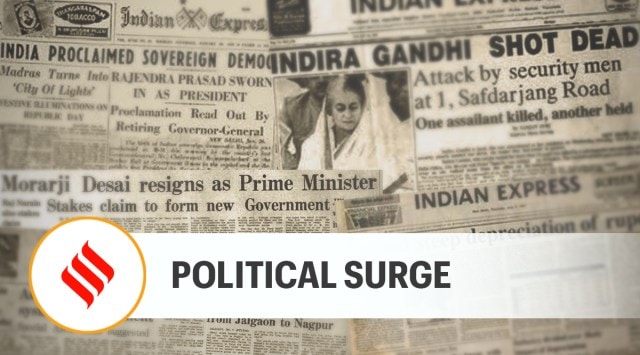- India
- International
Political surge
🔴 As the incumbent in four of the five states, the polls will be a verdict on BJP — and could reshape contours of the Opposition
 Of the five states that go to polls, the BJP is the incumbent in four. Uttar Pradesh is the most crucial since winning the state is central to the party’s plans for the 2024 general election.
Of the five states that go to polls, the BJP is the incumbent in four. Uttar Pradesh is the most crucial since winning the state is central to the party’s plans for the 2024 general election. Amid the surge of Omicron, the Election Commission has announced the dates for assembly elections in five states, beginning February 10, with several restrictions on campaigning. A consensus had emerged among political parties that polls be held on schedule. The onus is now on the parties to adhere to EC guidelines — for now, till the EC reviews the situation, they must hold virtual, digital campaigns instead of mega rallies. Political parties must let science and data on the pandemic’s trajectory guide the voters’ journey to the polling booths. They must take the EC’s cue — it has raised the limits on campaign expenditure — and devise innovative and safe campaigns.
 Of the five states that go to polls, the BJP is the incumbent in four. Uttar Pradesh is the most crucial since winning the state is central to the party’s plans for the 2024 general election. The BJP’s twin planks of Hindutva and “double-engine growth” — the latter formulation is based on the presumption that it needs the same party to hold office at the Centre and state to facilitate development — will be tested in UP, which sends 80 MPs to the Lok Sabha. The BJP, and Prime Minister Narendra Modi personally, have invested much political capital in UP in the past five years. Chief Minister Adityanath’s governance model, which addresses and privileges “Hindu sentiment” while being unforgiving of protest or dissent, will also be on test — no party has won two successive terms in UP since 1985. Modi’s frequent forays into the state, whether for laying the foundation stone of the Ram mandir in Ayodhya or for the inauguration of the Kashi Vishwanath corridor complex in his parliamentary constituency of Varanasi, have only served to up the stakes for the BJP. If UP is the state where other parties will find it challenging to battle the BJP, Punjab is for the Congress to lose. For the first time, the state is witnessing a multi-polar contest with the Congress, Shiromani Akali Dal (SAD), Aam Aadmi Party, farmers’ unions and the BJP in the fray. The farmers’ movement forced a split in the SAD-BJP alliance and diminished the influence of both parties but the leadership crisis and the rise of multiple power centres may hurt the Congress’s prospects. In Uttarakhand and Manipur, infighting threatens the BJP’s prospects of retaining office — the party was forced to change its CM twice in Uttarakhand and factionalism seems rampant in the Manipur BJP. The entry of Trinamool Congress and AAP complicates the picture in Goa, where elections have historically been bipolar and determined by local issues.
Of the five states that go to polls, the BJP is the incumbent in four. Uttar Pradesh is the most crucial since winning the state is central to the party’s plans for the 2024 general election. The BJP’s twin planks of Hindutva and “double-engine growth” — the latter formulation is based on the presumption that it needs the same party to hold office at the Centre and state to facilitate development — will be tested in UP, which sends 80 MPs to the Lok Sabha. The BJP, and Prime Minister Narendra Modi personally, have invested much political capital in UP in the past five years. Chief Minister Adityanath’s governance model, which addresses and privileges “Hindu sentiment” while being unforgiving of protest or dissent, will also be on test — no party has won two successive terms in UP since 1985. Modi’s frequent forays into the state, whether for laying the foundation stone of the Ram mandir in Ayodhya or for the inauguration of the Kashi Vishwanath corridor complex in his parliamentary constituency of Varanasi, have only served to up the stakes for the BJP. If UP is the state where other parties will find it challenging to battle the BJP, Punjab is for the Congress to lose. For the first time, the state is witnessing a multi-polar contest with the Congress, Shiromani Akali Dal (SAD), Aam Aadmi Party, farmers’ unions and the BJP in the fray. The farmers’ movement forced a split in the SAD-BJP alliance and diminished the influence of both parties but the leadership crisis and the rise of multiple power centres may hurt the Congress’s prospects. In Uttarakhand and Manipur, infighting threatens the BJP’s prospects of retaining office — the party was forced to change its CM twice in Uttarakhand and factionalism seems rampant in the Manipur BJP. The entry of Trinamool Congress and AAP complicates the picture in Goa, where elections have historically been bipolar and determined by local issues.
While the BJP has much to lose in these elections, the results could be transformative for the Opposition. The Congress is the main challenger of the BJP in the poll-bound states barring Punjab, where it is in a pivotal position. Failure to perform well in these elections will further dent the Congress’s claim to lead the Opposition space which is now bristling with ambitious regional forces. Goa is an important test for the TMC, while Punjab offers another opportunity for the AAP to grow beyond Delhi. March 10, when results come in, is likely to be a day of reckoning for both the ruling party and the Opposition.
EXPRESS OPINION
More Explained
Apr 26: Latest News
- 01
- 02
- 03
- 04
- 05


































